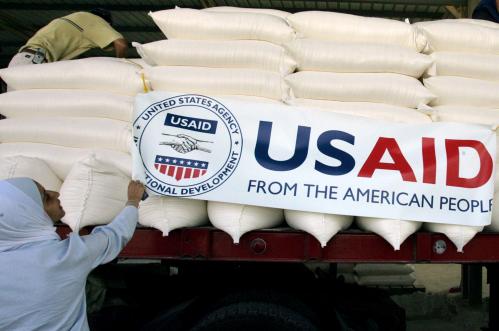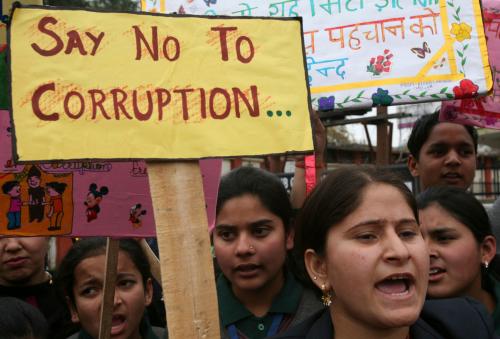The U.S. Agency for International Development (USAID) has launched a package of internal reforms to modernize its engagement with the private sector. The Agency has a long history of working with the private sector—on both sides of the development continuum, from partnering with American businesses in delivering development solutions to building up the local private sector. An example is USAID’s work with an Egyptian exporter association that strengthened agricultural exports and increased revenue by including smallholder farmers and exporters in the high-value horticultural value chains. Seeing the benefits of a more inclusive export sector, major Egyptian exporter associations began to increasingly seek smallholder farmer contracts.
The most concerted effort, the Global Development Alliance (GDA), was launched more than 20 years ago as a means to advance USAID’s engagement with the private sector and has resulted in more than 1,900 public-private partnerships over the past two decades. Despite, or maybe because of, being the bilateral donor that has gone the furthest in partnering with the private sector, USAID recognizes that new tools are needed to meet today’s unprecedented development challenges that require a more forward-leaning approach to scaling up public-private partnerships.
The timing is propitious. The G-7, major reports by independent experts, and U.S. Treasury Secretary Yellen have publicly prioritized the mobilization of private finance. Billions and trillions will be needed to address climate change, the loss of progress in advancing the Sustainable Development Goals (SDGs), COVID and conflict-induced poverty, and the astronomical cost of rebuilding Ukraine when Putin’s war is over. It is therefore essential that USAID have the tools to enlist the resources and capabilities of the private sector to meet these monumental demands.
With many corporations aligning their business strategies with the SDGs, the time is ripe for partnership with USAID. In 2021 USAID articulated how the private sector is integral to its work in a “Private Sector Engagement Policy” and highlighted the importance of public-private partnerships to achieve the global goals by 2030.
PSE Modernize
On November 17, 2022, USAID Administrator announced Private Sector Engagement (PSE) Modernize containing the following nine changes to its business model:
|
Mission Capacity Index |
Relationship Management | Data & Reporting |
|
Community of Practice |
Future Workforce |
Consultation Desk |
| Innovation Incubator | Learning Lab | Flexible Fund |
Although each component is an important step, several are especially critical to USAID’s engagement with the private sector and require further strengthening to ensure the announcement of this initiative endures and leads to greater development impact.
Staffing and Resources
One of the greatest challenges USAID faces is the lack of staff and resources to deliver on the promise of engaging the private sector. The Mission Capacity Index is a new data system that will provide USAID country missions and Washington bureaus with information on their staffing capability to scale PSE programming. Rather than long technical documents, engaging the private sector requires unique communication skills based on slide decks and a deep understanding of the drivers for corporate partners, as well as the agility to respond quickly. While some USAID officers have these skills or could rapidly adopt them, the agency must invest and reward its staff to ensure these skills endure beyond this administration. Creating agency awards around PSE and incorporating objectives and targets into employee performance plans are just a few ways to incentivize staff.
The PSE Future Workforce Program will provide a needed focus on attracting and retaining private-sector talents in the agency. A step further would be to make PSE expertise a separate cone within the USAID personnel system to ensure those employees that their expertise is valued, and that they have a path for career advancement.
USAID has had staff members assigned to maintain the relationship with certain private sector partners. But this has been on top of other responsibilities and seldom rewarded. Under “Relationship Management” those positions will be prioritized and become more structured and formalized in the workforce plan.
The Consultation Desk, Innovation Incubator, and Learning Lab can be seen as a trio of knowledge units to provide missions and Washington bureaus access to PSE expertise, PSE innovative tools and authorities, and a repository of PSE resources. Due to a lack of resources, these endeavors are slated to be placed on the back burner. But they are critical tools for staff to perform their responsibilities in a smart and coherent manner, so priority should be placed on finding the modest resources needed to launch them.
A community of practice is a proven instrument for sharing experiences and learning. The PSE Community of Practice is designed to be internal to USAID. To be truly impactful, it should also encompass private-sector participation.
Flexible Fund
The Flexible Fund takes further an underused authority in the FY 2022 foreign operations appropriations act that allows $50 million in development assistance and economic support funds used for private-sector partnerships to be available for use for three years (rather than the usual two years). If approved by Congress, the Flexible Fund, at a suggested $80 million for fiscal year 2023, would be the first time USAID had a discrete pot of money just for partnering with the private sector.
A model for this fund could be the Complex Crisis Fund (CCF) which enables USAID missions to access resources quickly per a short application to USAID/Washington. Like the CCF’s ability to act rapidly to prevent or respond to a crisis, the PSE Flexible Fund would enable missions to quickly respond to an opportunity with the private sector. Often, USAID staff and partners in-country are unable to capitalize on unique opportunities to create private-sector partnerships because USAID’s current procurement options, including the Global Development Alliance, just do not move fast enough, often requiring many months of endless meetings to reach closure. An agile fund enabling missions to rapidly draft a concept note to USAID’s PSE hub would not only provide funding but also technical assistance to missions that could significantly leverage USAID’s partnerships with the private sector.
Additional Recommendations
Beyond these practical initiatives, several additional steps the authors have proposed in earlier writings (here, here, and here) would further advance “PSE Modernize.”
A particularly important element in upping USAID’s game with the private sector is enhanced collaboration with the Development Finance Corporation (DFC). USAID has a deep understanding of development, experience providing technical assistance, and a wide array of activities that can benefit from private-sector partnerships. The DFC has the tools of finance (debt, equity, and guarantees) and insurance. Joining their respective capabilities, the two agencies can enhance their engagement with the private sector through deploying blended finance and technical assistance that will derisk private investment to build more sustainable activities.
A second area for action is the need to revise USAID procurement rules and processes to make them timelier and more amenable to how the private sector functions. A constant mantra from the private sector is the need to quickly get to “yes” or “no”. We hear of too many instances in which corporations have just walked away because trying to work with USAID was too complex and time-consuming. The agency should join together to mandate the exigencies of three initiatives that require the simplification of agency procedures. On November 28 Administrator Power announced the Burden Reduction Program to “reduce bureaucratic burdens and so-called time taxes imposed and/or experienced by the Agency.” Similarly, a critical part of the heightened agenda on locally-led development is to make USAID rules and regulations simpler in order to be more accessible to local organizations in partner countries. Incorporating PSE Modernize into these efforts to simplify USAID requirements and procedures would make it easier for the private sector, both local and international, to comply with the agency’s procedures for procurement, reporting, and accountability.
Thirdly, just as it is recognized that USAID lacks sufficient numbers of contracting officers to handle current procurement actions, much less the greater number that will result from partnering with local organizations, the agency also lacks sufficient contracting officers experienced in dealing with private companies. One example of where this will be absolutely critical is the rebuilding of Ukraine. The private sector will play a pivotal role in Ukraine’s reconstruction efforts. USAID would be wise to staff up now with needed contract and PSE experts, as well as bolster its Europe and Eurasia bureau which is chronically understaffed to manage billions of dollars in assistance.
Today’s development challenges require new and enhanced tools to engage the private sector. Administrator Power’s announcement in November is a good start. The proof will be in whether USAID can move more quickly to form meaningful private-sector partnerships that will endure beyond the headline.








Commentary
Enhancing USAID’s partnerships with the private sector
January 9, 2023